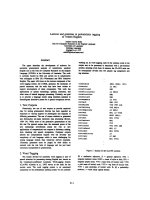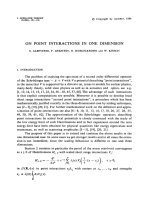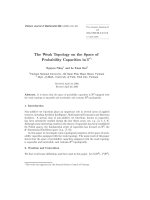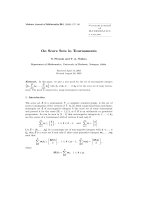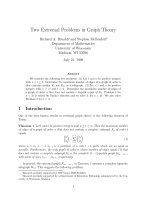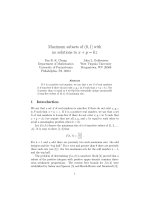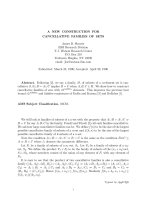Báo cáo toán học: "Maximum Independent Sets in Certain Powers of Odd Cycles" doc
Bạn đang xem bản rút gọn của tài liệu. Xem và tải ngay bản đầy đủ của tài liệu tại đây (116.19 KB, 8 trang )
Maximum Independent Sets in Certain Powers
of Odd Cycles
Tom Bohman
∗
Ron Holzman
†
Venkatesh Natarajan
‡
Submitted: Jan 2, 2008; Accepted: Jul 6, 2009; Published: Jul 24, 2009
Mathematics Subject Classification: 05C38, 05C69
Abstract
We give a complete classification of all maximum independent sets in powers of odd
cycles of the form C
d
k2
d
+1
.
1 Introduction
Consider the following nat ura l packing problem: How many d-dimensional cubes of side
length 2 can we pack into a d-dimensional torus with a fixed, odd side length? This
problem can be formulated in terms of graph products as fo llows. If G
1
= (V
1
, E
1
) and
G
2
= (V
2
, E
2
) are graphs then let G
1
× G
2
be the graph with vertex set V
1
× V
2
and an
edge between distinct vertices (u
1
, u
2
) and (v
1
, v
2
) if and only if u
i
= v
i
or {u
i
, v
i
} ∈ E
i
for i = 1, 2. The graph power G
d
is then the product of G with itself d times. A packing
of cubes of side length 2 in the d-dimensional torus of side length 2n+ 1 corresponds to an
independent set in C
d
2n+1
. (This correspondence between packings of cubes in the torus
and independent sets in powers of odd cycles wa s first noted by Baumert et al [1]).
Let α ( G) denote the independence number o f graph G, i.e., the maximum size of an
independent set in G. The independence numbers of the powers of odd cycles are also
related to a central open question on the Shannon capacities of graphs. The Shannon
capacity of the graph G is defined as
c(G) = sup
d
α
G
d
1/d
∗
Department of Mathematical Sciences, Carnegie Mellon Unive rsity, Pittsburgh, USA. Supported in
part by NSF grant DMS 0401147. E-mail:
†
Department of Mathematics, Technion–Israel Institute of Technology, Haifa, Israel. Re search sup-
ported by the Fund for the Promotion of Research at the Technion and by the P. and E. Nathan Research
Fund. E-mail:
‡
Department of Mathematical Sciences, Carnegie Mellon University, Pittsburgh, USA.
the electronic journal of combinatorics 16 (2009), #N26 1
and gives a measure of optimal zero-error p erfo r mance of an associated communication
channel [6]. The odd cycles on seven or more vertices and their complements are, in a
certain sense, the simplest graphs for which the Shannon capacity is not known. This
follows fro m the Strong Perfect Graph Theorem. The Shannon capacity o f C
5
= C
5
was
determined in a celebrated paper of Lov´asz [5]. For a survey of zero-error information
theory see [4].
The problem of determining the independence numbers of arbitrary products of odd
cycles remains widely open. The best known upper bounds on these independence num-
bers are given (in most cases) by the Lov´asz-theta function ϑ(G) (which, for the sake of
brevity, we do not define here) or the fractional vertex packing number α
∗
(G) and the
simple fact
α(G × H) ≤ α(G)α
∗
(H).
The fractional vertex packing number of the graph G is the maximum, over all assignments
of non-negative real weights to the vertices of G with the property that the sum of weights
over any clique is at most 1, of the sum of weights of the vertices of G. The independence
numbers are known in the following cases:
α
C
2j
5
= 5
j
= ϑ(C
5
)
2j
(1)
α
C
d
k2
d
+1
= k(k2
d
+ 1)
d−1
= k2
d−1
k2
d
+ 1
2
d−1
= α(C
k2
d
+1
)α
∗
C
d−1
k2
d
+1
(2)
α
C
d
k2
d
+3
=
k(k2
d
+ 3)
d
+ 1
k2
d
+ 1
=
2k(k2
d
+ 3)
d−1
+ 1
k2
d
+ 1
k2
d
+ 3
2
(3)
=
α
C
d−1
k2
d
+3
α
∗
(C
k2
d
+3
)
Equation (1) was established in the celebrated paper of Lov´asz [5]. Hales [3] and Baumert
et al [1 ] independently established (2), and Baumert et al [1] proved (3). The authors
of this paper recently made progress on α(C
3
8k+ 5
): This independence number has been
determined for 8k +5 prime and within an additive er r or of 2 for arbitrary k [2]. The only
other power of an odd cycle for which the independence number is known is α(C
3
7
) = 33
(this is established in [1] by an ad hoc argument aided by a computer search).
When the independence number is known, it is natural to ask for a description of all
maximum independent sets. In addition to the inherent interest in such a characteriza-
tion, it may serve as a stepping stone for o bta ining upper bounds on the independence
numbers of higher powers. For example, a classification of maximum and almost maxi-
mum independent sets in C
2
4ℓ+1
was the key to obtaining the upper bound on α(C
3
8k+ 5
) in
[2]. In other related work, the authors exploited structural properties of near maximum
independent sets in C
2
9
and C
3
9
to establish the upper bound α(C
4
9
) ≤ 350.
In this note we give a complete classification of the maximum independent sets that
achieve equality in (2). These indep endent sets are also the starting point for the known
constructions of independent sets that achieve (3); Baumert et al established (3) by in-
troducing an operation that transforms a ma ximum independent set in C
d
k2
d
+1
into a
maximum independent set in C
d
k2
d
+3
.
the electronic journal of combinatorics 16 (2009), #N26 2
In order t o state our results we need some definitions. Throughout the paper we
identity the vertex set o f C
2n+1
and Z
2n+1
in the natural way. Operations on vertices will
be assumed to be over this ring unless otherwise noted. Given a set I ⊆ [d] with |I| = ℓ
and a vector x ∈ Z
ℓ
2n+1
, the slice of C
d
2n+1
given by I = {i
1
, . . . , i
ℓ
} and x = (x
1
, . . . , x
ℓ
)
is the set of vertices
(v
1
, . . . , v
d
) ∈ C
d
2n+1
: v
i
j
∈ {x
j
, x
j
+ 1} f or j = 1, . . . , ℓ
.
Note that when we drop the coordinates in I this slice projects onto the gra ph C
d−|I|
2n+1
.
Furthermore, if S is an independent set in C
d
2n+1
then S intersected with the slice maps
onto an indep endent set in C
d−|I|
2n+1
under this projection. The dimension of the slice given
by I and x is d − |I|.
Let S be an independent set in C
d
2n+1
. A maximal clique K in C
d
2n+1
is a hole of S if
K ∩S = ∅. We let H(S) denote the set of holes of the independent set S. Note that there
is a natural correspondence between maximal cliques and vertices: We say that v is a hole
if K
v
:= {v} +{0, 1 }
d
is a hole. Note that if S
1
and S
2
are independent sets in C
d
2n+1
then
H(S
1
) = H(S
2
) if and only if S
1
= S
2
. (To see this, consider the set of 1-dimensional
slices through a clique K
v
that is not a hole. The holes in these slices determine the
location of the one vertex in S ∩ K
v
by parity.) Also note that the holes in a slice of an
independent set S correspond to holes in H(S).
We say that independent sets S, T in C
d
2n+1
are isomorphic, and write S
∼
=
T , if there
is a graph automorphism ϕ of C
d
2n+1
such that ϕ(S) = T . No t e that the automorphism
group of C
d
2n+1
is generated by translation, negation and permutation of coordinates.
Let k and d be positive integers. We define a cyclic factorization of k of length d
to be a directed cycle p = (p
1
, p
2
, . . . , p
d
) of positive integers such that
d
i=1
p
i
= k. Note
that, as these integers are arranged in a cycle, we have (p
1
, p
2
, . . . , p
d
) = (p
2
, p
3
, . . . , p
d
, p
1
),
but we do distinguish between cycles with opposite orientations.
Now we are ready to state our classification. We begin by introducing a collection o f
maximum independent sets.
Lemma 1. If p = (p
1
, p
2
, . . . , p
d
) is a cyclic factorization of k of length d then there exists
a maximum independent set S
p
in C
d
k2
d
+1
such that
H (S
p
) =
(x
1
, . . . , x
d
) ∈ Z
d
k2
d
+1
: x
1
+
d
i=2
i−1
j=1
2p
j
x
i
= 0
.
Note that the set H(S
p
) defined in the Lemma, and therefore also the set S
p
, actually
depends on the way the cyclic factorization p is listed. Nevertheless, using t he fact that
d−1
j=1
2p
j+1
= −(2p
1
)
−1
it can be checked that the set corresponding to (p
2
, p
3
, . . . , p
d
, p
1
)
is isomorphic to the one corresponding to (p
1
, p
2
, . . . , p
d
), and so the notation S
p
is justified
up to isomorphism.
Our main result is that the collection of independent sets defined in Lemma 1 is, up
to isomorphism, the complete list of maximum independent sets in C
d
k2
d
+1
.
the electronic journal of combinatorics 16 (2009), #N26 3
Theorem 2. If S is a maximum independent set in C
d
k2
d
+1
then there exists a unique
cyclic factorization p of k of length d such that S
∼
=
S
p
.
The d = 2 case of Theorem 2 was established by Baumert et al [1]. This special case plays
a key role in the proof.
Before proceeding to the proofs, we establish a fact that we use throughout. Note
first that if S is an independent set in C
d
k2
d
+1
then the intersection of S with each 1-
dimensional slice projects onto an independent set in C
k2
d
+1
and therefore contains at
least one hole. It follows that any independent set in C
d
k2
d
+1
has at least (k 2
d
+ 1)
d−1
holes. On the other hand a maximum independent set has exactly (k2
d
+ 1)
d−1
holes
(as each vertex is in 2
d
maximal cliques). It follows that a maximum independent set in
C
d
k2
d
+1
has exactly one hole in each 1-dimensional slice. Consequently, the intersection of
S with each ℓ-dimensional slice projects onto a maximum independent set in C
ℓ
k2
d
+1
.
2 Proof of Lemma 1
Fo r ease of notation we set s
1
= 1 and s
i
=
i−1
j=1
2p
j
for i = 2, . . . , d. We define an
independent set S
′
p
as follows:
T
i
= {−p
i
− 1 + 2j : j = 1, . . . , p
i
} T = T
1
× T
2
× · · · × T
d
H =
(x
1
, . . . , x
d
) ∈ Z
d
k2
d
+1
:
d
i=1
s
i
x
i
= 0
S
′
p
= H + T.
First, we show that S
′
p
is an independent set. Since T itself is a n independent set and
H is a subgroup of Z
d
k2
d
+1
, it suffices to show
H ∩ [−2p
1
+ 1, 2p
1
− 1] × · · · × [−2p
d
+ 1, 2p
d
− 1] = {0}.
Assume for the sake of contra diction that there is a non-zero element x = (x
1
, . . . , x
d
) of
H that is also in the set [−2p
1
+ 1, 2p
1
− 1] ×· · ·× [−2p
d
+ 1, 2p
d
− 1 ]. Let j be the largest
index such that x
j
= 0. We have, working over Z,
j−1
i=1
s
i
x
i
≤
j−1
i=1
s
i
(2p
i
− 1)
=
j−1
i=1
s
i
(2p
i
) − s
i
=
j−1
i=1
s
i+1
− s
i
= s
j
− s
1
.
It follows that 0 < |
j
i=1
s
i
x
i
| < k2
d
, a contradiction.
the electronic journal of combinatorics 16 (2009), #N26 4
Now we consider H(S
′
p
). We begin by noting that
|S
′
p
| = |H| · |T | = k(k2
d
+ 1)
d−1
;
that is, S
′
p
is a maximum independent set. It follows that S
′
p
has exactly o ne ho le in
each 1-dimensional slice. Furthermore, the set of holes is symmetric with respect to H:
If v ∈ H(S
′
p
) then H + v ⊆ H(S
′
p
). It follows that H(S
′
p
) is simply a translation of H,
and some translation of S
′
p
gives the desired independent set S
p
.
3 Proof of Theorem 2
The d = 2 case of Theorem 2, proved in [1], plays a central role in the proof. We rephrase
it as:
Lemma 3 (Baumert et al). Let S be a maximum independent set in C
2
4ℓ+1
. There exists
α such that α | ℓ and
(t
1
, t
2
) ∈ H(S) ⇒ (t
1
, t
2
) + (2α, 1) ∈ H(S).
Let d ≥ 3 and let S be a maximum independent in C
d
k2
d
+1
. Note that, since the
intersection of S with any 2-dimensional slice projects onto a maximum independent set
in C
2
k2
d
+1
, we can apply Lemma 3 to said intersections. Thus, Lemma 3 implies that
the holes in every 2-dimensional slice are a translate of some subgroup of Z
2
k2
d
+1
with an
appropriately chosen generator.
We now note some relations among the generators for intersecting and parallel pairs
of 2-dimensional slices.
Lemma 4. Let S be a maximum independent set in C
3
8m+1
and let a
0
, . . . , a
8m
, b be divisors
of 2m such that
(x, y, j) ∈ H(S) ⇒ (x + 2a
j
, y + 1, j) ∈ H(S)
for each j ∈ Z
8m+1
, and
(x, 0, z) ∈ H(S) ⇒ (x + 2b, 0, z + 1) ∈ H(S).
Assume that |b| ≥ |a
j
| for all j ∈ Z
8m+1
. Then there exists a so that a
j
= a for all
j ∈ Z
8m+1
, and b is a multiple of 2a.
Proof. For a positive integer t and any integer s, let s
(t)
be the unique integer in {1, . . . , t}
congruent to s modulo t. Let I
+
2t
= {1, . . . , t} and I
−
2t
= {t + 1, . . . , 2t}.
We consider two adjacent values of j, say j = 0, 1. We assume without lo ss of generality
that (0, 0, 0 ) ∈ H(S), that |a
0
| ≥ |a
1
|, and that b > 0. Consider the 1-dimensional slice
the electronic journal of combinatorics 16 (2009), #N26 5
Z
8m+1
× {0, 1} × {0, 1}. For each integer i ∈ {1, . . . , 4m} there is a vertex (2i, y
i
, z
i
) ∈ S,
where y
i
is determined by i
(2|a
0
|)
as follows:
i
(2|a
0
|)
∈ I
sgn(a
0
)
2|a
0
|
⇒ y
i
= 0,
i
(2|a
0
|)
∈ I
− sgn(a
0
)
2|a
0
|
⇒ y
i
= 1.
Similarly, z
i
is determined by i
(2b)
:
i
(2b)
∈ I
+
2b
⇒ z
i
= 0,
i
(2b)
∈ I
−
2b
⇒ z
i
= 1.
We a lso consider the 1-dimensional slice Z
8m+1
× {0, 1} × {1, 2}. Note that this slice has
a hole at (2b, 0, 1). For each i ∈ {b + 1, . . . , 4m} there is a vertex (2i, u
i
, v
i
) ∈ S where u
i
is determined by (i − b)
(2|a
1
|)
:
(i − b)
(2|a
1
|)
∈ I
sgn(a
1
)
2|a
1
|
⇒ u
i
= 0,
(i − b)
(2|a
1
|)
∈ I
− sgn(a
1
)
2|a
1
|
⇒ u
i
= 1.
Let J = {4m − |a
0
| + 1, . . . , 4m}. Note that for all i ∈ J we have i
(2b)
∈ I
−
2b
(since
2b | 4m and |b| ≥ |a
0
|) and hence z
i
= 1. Therefore we must have y
i
= u
i
for all i ∈ J.
As y
i
is constant for i ∈ J, it must b e the case that u
i
is the same constant for i ∈ J.
Since |a
0
| ≥ |a
1
|, this implies that |a
0
| = |a
1
| and one of the following two alternatives
holds: either sgn(a
0
) = sgn(a
1
) and b is an even multiple o f |a
1
|, or sgn(a
0
) = sgn(a
1
) and
b is an odd multiple of |a
1
|. Repeating the argument for every pair of adjacent values of
j ∈ Z
8m+1
, we conclude t hat all a
j
have the same absolute value, and the same alternative
among the two holds throughout (since b is the same). But the second alternative cannot
hold all around the odd cycle, so it must be the first alternative.
Fo r a maximum independent set S in C
d
k2
d
+1
and two distinct coordinates i, j ∈ {1, . . . , d},
we say that the pair (i, j) is aligned if there exists ∆
i,j
such that
v ∈ H(S) ⇒ v + e
i
+ ∆
i,j
e
j
∈ H(S),
where e
ℓ
denotes the ℓ-th standard unit vector. This means that a ll 2-dimensional slices
with co ordinates i, j have the same generator. Note that ∆
i,j
is an even divisor of k2
d−1
,
and that if (i, j) is aligned then so is (j, i) and we have ∆
j,i
= ∆
−1
i,j
.
Lemma 5. Let S be a maximum independent set in C
d
k2
d
+1
. Then every pair (i, j) of
distinct coordinates is aligned. Moreover, for any three distinct coordinates i, j, ℓ we have
∆
i,j
∆
j,ℓ
∆
ℓ,i
= −1.
Proof. We will prove the Lemma in the case d = 3. The g eneral case then follows by
considering the intersection of S with each 3-dimensional slice.
the electronic journal of combinatorics 16 (2009), #N26 6
Among all 2-dimensional slices in C
3
8m+1
, we choose one with generator 2b so that |b|
is as large as possible. We may assume that this is the slice Z
8m+1
× { 0, 1} × Z
8m+1
, so
that we have
(x, 0, z) ∈ H(S) ⇒ (x + 2b, 0, z + 1) ∈ H(S).
It follows from Lemma 4 that the pair (2, 1) is aligned.
Next, we show that alignment is contagious: once a pair is aligned, the other pairs
must also be aligned. Consider for example the pair (2, 3). For each i ∈ Z
8m+1
there is a
divisor c
i
of 2m such that
(i, y, z) ∈ H(S) ⇒ (i, y + 1, z + 2c
i
) ∈ H(S).
Now, fix a value of i. For an appropriate j, we have (i, 0, j) ∈ H(S). We successively
deduce that the following are holes: (i+2b, 0, j+1), (i, −2b∆
1,2
, j+1), (i, 0, j+1+4b∆
1,2
c
i
).
Since a 1-dimensional slice has only one hole, we conclude that 4b∆
1,2
c
i
+ 1 = 0. This
uniquely determines c
i
, so the value of c
i
is independent of i. By a similar argument, the
pair (1, 3) is also aligned. Noting that in the above calculation we have 2b = ∆
3,1
and
2c
i
= ∆
2,3
, we obtain that ∆
1,2
∆
2,3
∆
3,1
= −1.
Since the set of holes determines the independent set, the collection {∆
i,1
: i = 2, . . . , d }
determines S up to translation. By negating and permuting coordinates, we may assume
0 > ∆
2,1
≥ ∆
3,1
≥ · · · ≥ ∆
d,1
. Lemma 4 then implies that ∆
j+1,1
is a multiple of 2∆
j,1
for j = 2, . . . , d − 1. Set
p
j
=
−∆
2,1
2
if j = 1
∆
j+1,1
2∆
j,1
if j ∈ {2, . . . , d − 1}
−k2
d
2∆
d,1
if j = d.
Clearly, p = (p
1
, . . . , p
d
) is a cyclic factorization of k of length d. Furthermore S
p
is a
translation of S (as the generators ∆
i,j
are the same for both).
It remains to establish uniqueness. Let S be a maximum independent set and assume
0 > ∆
2,1
≥ ∆
3,1
≥ · · · ≥ ∆
d,1
. Note that the cyclic factorization p defined above is
uniquely determined except for the special role of the first coordinate. We could con-
ceivably arrive at a different cyclic factorization by working with the set of generators
{∆
i,ℓ
: i = ℓ} for any ℓ ∈ {2, . . . , d}. In the calculations below we adopt the convention
∆
i,i
= −1. Note that we have
∆
i,ℓ
= −∆
i,1
∆
−1
ℓ,1
= ∆
i,1
k2
d
∆
ℓ,1
.
It follows that we have
ℓ < i ≤ d ⇒ ∆
i,ℓ
= −
∆
i,1
∆
ℓ,1
and 1 ≤ i < ℓ ⇒ ∆
i,ℓ
= ∆
i,1
·
k2
d
∆
ℓ,1
,
the electronic journal of combinatorics 16 (2009), #N26 7
and
|∆
ℓ+1,ℓ
| ≤ · · · ≤ |∆
d,ℓ
| ≤ |∆
1,ℓ
| ≤ · · · ≤ |∆
ℓ−1,ℓ
|.
Fro m this ordered collection we get the following sequence of factors (in the case ℓ = d
the first two rows should be ignored):
−∆
ℓ+1,ℓ
2
=
∆
ℓ+1,1
2∆
ℓ,1
ℓ + 1 ≤ j < d ⇒
∆
j+1,ℓ
2∆
j,ℓ
=
∆
j+1,1
2∆
j,1
−∆
1,ℓ
2∆
d,ℓ
=
k2
d
∆
ℓ,1
2
−∆
d,1
∆
ℓ,1
=
−k2
d
2∆
d,1
1 ≤ j < ℓ − 1 ⇒
∆
j+1,ℓ
2∆
j,ℓ
=
∆
j+1,1
2∆
j,1
k2
d
2∆
ℓ−1,ℓ
=
∆
ℓ,1
2∆
ℓ−1,1
.
Thus, working with the generators {∆
i,ℓ
: i = ℓ} we arrive at the same cyclic factorization.
References
[1] L. Baumert, R. McEliece, E. Rodemich, H. Rumsey, R. Stanley, H. Taylor, A com-
binatorial packing problem, Computers in Algebra and Number Theory, Providence,
American Mathematical Society, 1971, pp. 97-108.
[2] T. Bohman, R . Holzman, V. Natarajan, On the independence numbers of the cubes
of odd cycles, manuscript.
[3] R. S. Hales, Numerical invariants and the strong product of graphs, Journal of Com-
binatorial Theory – B 15 (1973), 146-15 5.
[4] J. K¨orner and A. Orlitsky, Zero-error information theory, IEEE Transactions on
Information Theory 44 (1998), 2207-22 29.
[5] L. Lov´asz, On the Shannon capacity of a graph, IEEE Transactions on Information
Theory 25 (1979), 1-7.
[6] C. E. Shannon, The zero-error capacity of a noisy channel, IRE Transactions on
Information Theory 2 (1956), 8–19.
the electronic journal of combinatorics 16 (2009), #N26 8
